When you buy through our links, we may earn a commission. Products or services may be offered by an affiliated entity. Learn more.
A new mattress represents a significant investment for most households, so you should strive to find the best option within your budget. Today’s shoppers can choose from plenty of high-value beds at different price-points. The best bed for the money depends on how much you want to spend. Our top picks include budget-friendly beds, mattresses with mid-range sticker prices, and high-end luxury models. The common denominators are high-quality materials and strong ratings across different performance categories to ensure a great return on your investment.
Our Tip Picks
-
Best Mattress Overall – Helix Midnight Luxe
View Details
-
Best Foam Mattress – Nectar Classic
View Details
-
Best Mattress for Side Sleepers – Bear Original
View Details
-
Best Mattress for Back Pain – Silk & Snow Hybrid
View Details
Swipe for more
Best Mattress Overall
Helix Midnight Luxe
9.7 /10
Test Lab Score
25% off sitewide
25% off sitewide
Pocketed coils in the Helix Midnight Luxe ensure great edge support and breathability. For a hybrid, it’s surprisingly quiet and transfers very little movement from one side of the bed to the other. The comfort system also offers standout pressure relief, with conforming foams that adapt to the shape of your hips and shoulders.

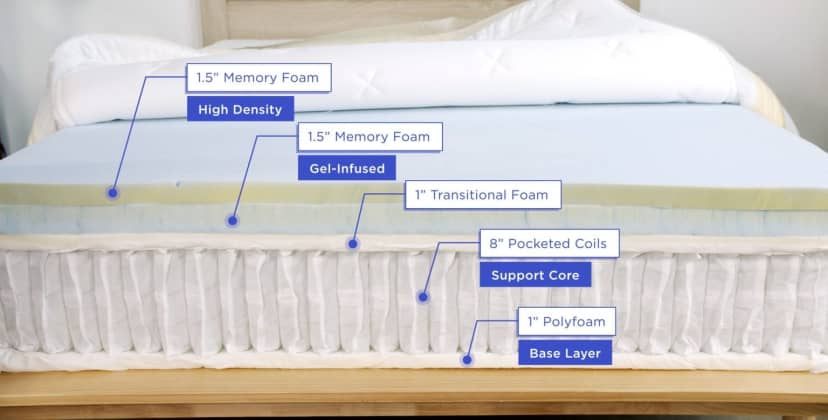

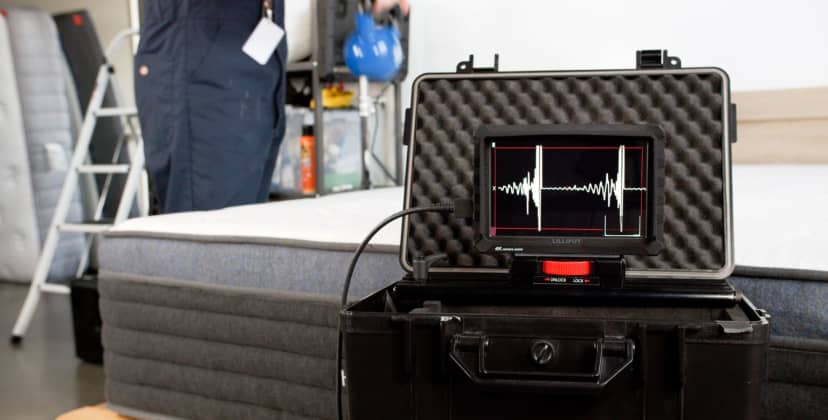
Credit: Sleep Foundation Test Lab
Price
$1,799
Mattress Type
Hybrid
Firmness Options
Medium Firm (6)
Trial Period
120 nights (30-night requirement)
At a Glance
- Who it’s best for: Side sleepers up to 230 pounds, and back sleepers between 130 and 230 pounds.
- Feel: Medium firm (6) design with gentle contouring and targeted support for the torso and hips.
- What It’s Made of: Two memory foam comfort layers, followed by transitional polyfoam and zoned pocketed coils with perimeter reinforcement.
- What We Don’t Like: Most stomach sleepers will find this mattress to plush and prone to uncomfortable sinkage.
Scoring & Reviews
The following ratings show how suitable this mattress is for different sleeping positions and sleeper weights. These scores are determined by how well the mattress supports and relieves pressure for each sleeper type.
We performed a meta-analysis on 5876 validated customer reviews of the Helix Midnight Luxe. This is what people who bought the mattress had to say:- Comfort and Support: Many reviewers express that the mattress provides exceptional comfort and support, especially noting its ability to alleviate back, hip, and shoulder pain.
- Sleep Quality Improvement: The mattress is frequently described as transformative for those who previously struggled with sleep disturbances.
- Temperature Regulation: Positive remarks are made about the cooling properties of the mattress. Users find the cooling aspect effective, helping to maintain a comfortable sleeping temperature throughout the night.
- Customer Service: Experiences with customer service are predominantly positive, with buyers appreciating the responsive and helpful nature of the support team. Issues are resolved satisfactorily, contributing to a positive overall customer experience.
- Durability Concerns: A few reviewers express concerns about the mattress showing signs of wear or sagging prematurely. These concerns are not widespread but are significant enough to be noted by potential buyers.
- Mixed Reviews on Firmness: While many find the mattress perfectly balanced, there are mixed reviews regarding its firmness. Some users find it softer than expected given its firmness level. While the ‘medium firm’ rating is appropriate by our measurements, the bed does have a ‘cushy’ foam feel that makes for a fairly soft surface feel.
Full Details
Side sleepers tend to put more pressure on their joints compared to other sleep positions. The Helix Midnight Luxe features two memory foam comfort layers that closely contour to the body and reduce pressure buildup in your most sensitive areas.
How It Performs
Our testing found the foam layers and medium firm (6) feel performed best with side sleepers who are at least 130 pounds. Sleepers who frequently experience joint pain also found the memory foam comfort layer significantly reduced pressure-induced pain in these areas. Thanks to air circulation from the coil support core, the mattress keeps cooler compared to other models made with memory foam. Hot sleepers who enjoy the “body-hugging” feel of memory foam but find it retains too much heat may like the Helix Midnight.
Construction Breakdown
A cover made of moisture-wicking Tencel fabric encases the mattress. This material is stretchy and breathable to allow for more air circulation. Memory foam comfort layers provide plush surface-level cushioning, while a transitional polyfoam layer beneath helps evenly distribute weight and acts as a cushion between the comfort layers and the support core. Pocketed coils make up the support core. These coils are zoned to help lift the wider areas of the body and keep the spine aligned. Thicker coils line the perimeter for reinforcement, allowing sleepers to sit or sleep closer to the edge. A final base layer made from polyfoam prevents shifting.
Trial, Shipping, and Warranty
Along with a competitive price-point for the Midnight, Helix offers free ground shipping throughout the contiguous U.S. Midnight mattress purchases are backed by a 120-night sleep trial and a lifetime warranty protecting against structural defects.
Best Mattress for Couples
Brooklyn Bedding CopperFlex Memory Foam
8.6 /10
Test Lab Score
30% off sitewide
30% off sitewide
If you’re shopping for a mattress with your partner, the Brooklyn Bedding CopperFlex offers exceptional long-term value at an affordable price tag. The sophisticated design incorporates six individual foam layers to ensure ample cushioning on the surface and sturdy underlying support.

Credit: Sleep Foundation Test Lab
Price
$466
Mattress Type
Foam
Firmness Options
Medium Firm (6)
Trial Period
120 nights (30-night requirement)
At a Glance
- Who It’s Best for: Side sleepers of at least 130 pounds and back sleepers up to 230 pounds.
- Feel: Medium firm (6) design with plush contouring on the surface and extra reinforcement around the midsection.
- What It’s Made of: Adaptive polyfoam and copper-infused memory foam comfort layers, zoned transitional foam, and high-density foam base layers.
- What We Don’t Like: Edge support is limited, so the perimeter may buckle and sink.
Scoring & Reviews
The following ratings show how suitable this mattress is for different sleeping positions and sleeper weights. These scores are determined by how well the mattress supports and relieves pressure for each sleeper type.
We performed a meta-analysis on 549 validated customer reviews of the Brooklyn Bedding CopperFlex Memory Foam. This is what people who bought the mattress had to say:- Pricing and Value: Many reviewers have highlighted that the mattress is affordable and offers great value for the price, making it an excellent choice for budget-conscious shoppers.
- Heat Regulation: Several users noted that the mattress does not retain much heat, which contributes to a cooler and more comfortable sleep, especially for those who tend to sleep hot.
- Edge Support: The mattress is reported to have good edge support, which is beneficial for those who use the edge of the bed frequently or sleep close to the sides.
- Odor and Off-Gassing: Some reviews mention that the mattress has minimal off-gassing odor upon unpacking, which is a common concern with new mattresses. The smell will dissipate in a few days.
- Hybrid Option: The availability of hybrid models is appreciated, particularly for those needing more support, such as individuals with larger frames.
- Customer Service: Positive remarks about customer service suggest that the company handles queries and issues effectively.
Full Details
Shopping for a new mattress with a partner can be challenging, especially if your personal preferences differ from theirs. Brooklyn Bedding’s CopperFlex Memory Foam is a versatile crowd-pleaser thanks to its balanced design and strong performance across key categories. An approachable sticker price further sweetens the deal for couples on a budget.
How It Performs
After evaluating the CopperFlex Memory Foam in our Test Lab, we’ve determined this mattress is best suited to side sleepers who weigh 130 pounds or more and back sleepers weighing 230 pounds or less. Stomach sleepers under 130 pounds may also find the CopperFlex comfortable, but heavier individuals who use this position and back sleepers over 230 pounds will probably experience excessive sinkage despite the zoned transitional foam and sturdy base layers.
The CopperFlex excels at motion isolation. During our tests, we observed very little movement transferring on the surface when testers changed sleep positions and got on and off of the mattress. Most of us also found that the CopperFlex sleeps at a cool temperature – there may be some slight heat retention, but this is minimal compared to other all-foam models we’ve tested.
Construction Breakdown
The CopperFlex’s six-layer construction begins with a thin layer of adaptive polyfoam sewn to the cover. Two memory foam layers add cushioning and contouring, and copper fiber infusions help push heat away from the surface. The transitional polyfoam is zoned to feel firmer beneath your torso and hips, and gentler around your head and legs.
The support core consists of two stacked high-density polyfoam layers. While these components stabilize the mattress, you may still notice some buckling along the perimeter. The cover is composed of GlacioTex, a specialty fabric engineered to feel cool at all times.
Trial, Shipping, and Warranty
Brooklyn Bedding offers free ground shipping throughout the contiguous U.S. Each order includes a sleep trial that runs for 120 nights with a 30-night break-in requirement before returns can be initiated. If you decide to keep the mattress after the trial ends, it’s further backed by a lifetime manufacturer’s warranty.
Best Foam Mattress
Nectar Classic
8.3 /10
Test Lab Score
Save up to 50% on mattresses + 15% off regular prices
Save up to 50% on mattresses + 15% off regular prices
Built with a generous comfort system and a supportive polyfoam core, the Nectar is notable for its ability to relieve pressure points. The mattress also provides surprisingly good edge support and near-perfect motion isolation. A 365-night sleep trial makes this a no-risk purchase.
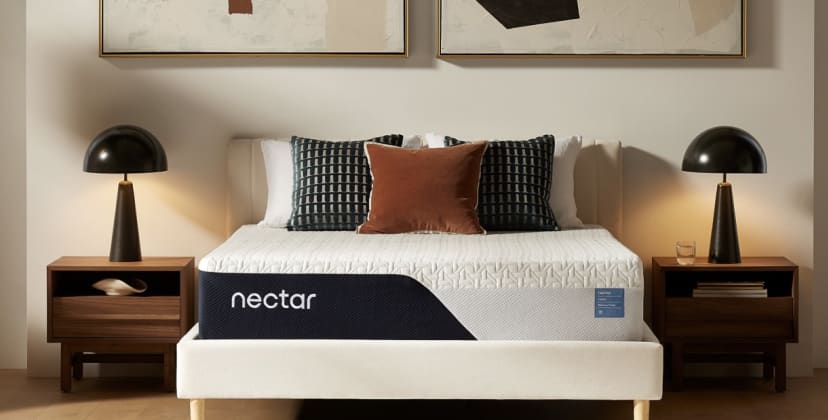
Price
$649
Mattress Type
Foam
Firmness Options
Medium Firm (6)
Trial Period
365 nights (30-night requirement)
At a Glance
- Who It’s Best for: Side sleepers who weigh at least 130 pounds, and back sleepers between 130 and 230 pounds.
- Feel: True medium firm (6) feel with deep contouring on the surface and sturdy underlying support.
- What It’s Made of: Memory foam comfort layer, followed by transitional and base layers of high-density polyfoam.
- What We Don’t Like: Foam layers can absorb and trap heat to an uncomfortable degree.
Scoring & Reviews
The following ratings show how suitable this mattress is for different sleeping positions and sleeper weights. These scores are determined by how well the mattress supports and relieves pressure for each sleeper type.
We performed a meta-analysis on 10000 validated customer reviews of the Nectar Mattress. This is what people who bought the mattress had to say:- Pain Relief: Many users have reported significant relief from back, neck, and joint pain. The mattress seems particularly beneficial for those with chronic pain, contributing to better overall sleep quality.
- Free Accessories: Nectar often includes free pillows, mattress protectors, and sheets with the mattress, adding value and convenience for new customers.
- Suitable for All Weights: The mattress supports a wide range of body weights and sizes without losing comfort or stability, making it versatile for different users.
- Temperature Regulation: Several reviews indicate that the mattress does a good job of staying cool throughout the night, which is a significant benefit for those who tend to sleep hot.
- Customer Service: Positive remarks about Nectar’s customer service are common, with many customers feeling supported during the purchasing and setup process.
- Durability Concerns: While many users find the mattress supportive and comfortable, there are occasional mentions of durability concerns, such as sagging or indentations developing over time, particularly from heavier users.
Full Details
Memory foam mattresses frequently have a price-point that falls well above what most people would consider to be affordable, but the Nectar is a welcome exception. With a competitive price and multiple layers of memory foam, it’s a compelling pick for people looking for pressure relief.
How It Performs
The Nectar has a medium firm feel that is sturdier than many other memory foam mattresses, meaning that it doesn’t cause the body to sink deeply into the bed. For this reason, it is a good option for most side sleepers, particularly those over 130 pounds, as well as many stomach and back sleepers who weigh up to 230 pounds. Side sleepers should appreciate the deep contour from the memory foam comfort layers, relieving pressure buildup in the hips and shoulders. These foam layers also absorb a significant amount of motion. Those easily disturbed by a partner’s nighttime movement should notice fewer disturbances.
Construction Breakdown
The first layer of gel-infused memory foam in the Nectar’s comfort system is quilted into the bed’s cover. Next is a thick layer of polyfoam, which sits on top of high-density polyfoam.
All together, the foam layers provide considerable cushioning to match where the body most needs it and ultimately promotes proper spinal alignment. A breathable Tencel cover encases the mattress.
Trial, Shipping, and Warranty
Even at an accessible price, a mattress is still a big investment, and Nectar recognizes that by allowing customers to try it out for 365 nights with the option to return it for a full refund. They also provide a lifetime warranty that includes coverage of potential mattress defects.
Best Mattress for Side Sleepers
Bear Original
7.8 /10
Test Lab Score
40% sitewide with code: SF40
40% sitewide with code: SF40
The Bear Original provides the motion isolation we expect from an all-foam model, but it also surprised us with its relatively strong edges. While not up to the standard of a hybrid, most couples should find they can use the entire surface of the bed without feeling too unstable around the perimeter.
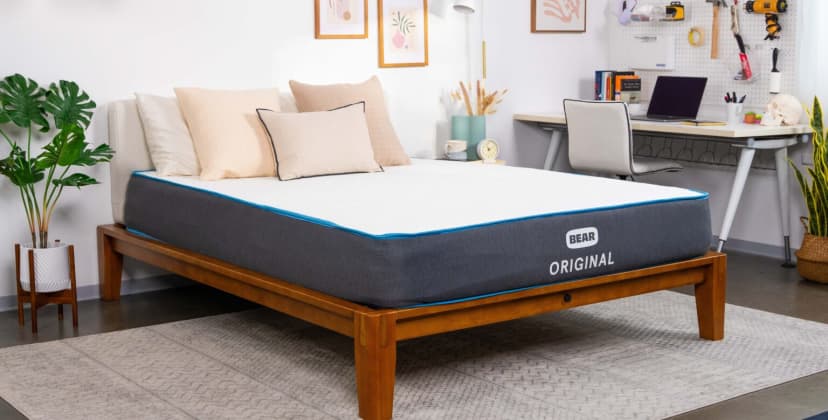
Credit: Sleep Foundation Test Lab
Price
$649
Mattress Type
Foam
Firmness Options
Firm (7)
Trial Period
120 nights (30-night break-in period)
At a Glance
- Who It’s Best for: Side and back sleepers who weigh at least 130 pounds.
- Feel: A firm (7) feel ensures light contouring and stronger support compared to the average memory foam mattress.
- What It’s Made of: Memory foam comfort layer, supportive transitional polyfoam, and a base layer of high-density foam.
- What We Don’t Like: Side sleepers under 130 pounds will probably find this mattress too firm.
Scoring & Reviews
The following ratings show how suitable this mattress is for different sleeping positions and sleeper weights. These scores are determined by how well the mattress supports and relieves pressure for each sleeper type.
We performed a meta-analysis on 10000 validated customer reviews of the Bear Original. This is what people who bought the mattress had to say:- Firmness and Comfort: Many reviewers find the Bear Original mattress to be on the firm side but still comfortable, providing a good balance of support and cushioning.
- Pain Relief and Support: Users frequently report relief from back and neck pain. The mattress offers good support, which contributes to a more restful sleep and helps with physical recovery, especially noted by athletes and those with physically demanding lifestyles.
- Adjustment Period: Some customers noted a need for an adjustment period where initially the mattress felt too firm, but became more comfortable after continuous use. This is typical, and we recommend using a mattress for at least two weeks before considering a return.
- Temperature Regulation: There are some mixed reviews regarding temperature control; some users mention that the mattress does a good job at staying cool, while a few others still experience heat retention. This is most likley due to the memory foam featured in the mattress. If you’re a particularly hot sleeper, you may want to look elsewhere.
- Ease of Setup: The mattress is easy to unbox and set up, and it quickly expands to its full size. Customers appreciate the ease of installation.
- Customer Service: Bear’s customer service is frequently praised for being responsive and helpful, enhancing the overall buying and service experience.
Full Details
The Bear Original stands out from competing all-foam mattresses with a slightly firmer design. It’s a good option for sleepers who enjoy moderate conforming without excessive sinkage. It’s also a good match for co-sleepers with differing preferences when it comes to foam beds.
How It Performs
Foam beds don’t always appeal to sleepers over 230 pounds due to their lack of support. However, the Bear Original earned high marks from side sleepers over 230 pounds and back sleepers over 130 pounds. These groups found the bed was firm enough to support their bodies while offering just the right amount of cushioning to avoid painful pressure buildup. Even many stomach sleepers, who don’t typically favor all-foam models, enjoyed the Bear Original.
The foam layers minimize motion transfer, making the mattress a good option for co-sleepers who wake each other up with nighttime movement. Pressure relief is another strength of this mattress thanks to even contouring from the foam layers.
Construction Breakdown
The mattress had a firm (7) feel, which is firmer than the average all-foam mattress. It begins with a memory foam layer that gently conforms to your body, followed by a polyfoam layer with more responsiveness. The support core is composed of high-density polyfoam that gives the bed a sturdy feel. The cover is made with a Tencel fabric that is naturally cool and breathable, but you can opt for a Celliant-infused cover for an extra fee to help cool the bed even further.
Trial, Shipping, and Warranty
Bear offers a 120-night sleep trial to try out the mattress at home. Beyond the sleep trial, you’ll also receive a lifetime warranty. Shipping is free to addresses in the contiguous U.S.
Best Affordable Luxury Mattress
Leesa Original Hybrid
8.6 /10
Test Lab Score
25% off sitewide
25% off sitewide
The Leesa Original Hybrid features outstanding edge support and strong temperature regulation thanks to its coil support core. Contouring foam layers provide moderate pressure relief without causing sleepers to feel stuck in the bed.
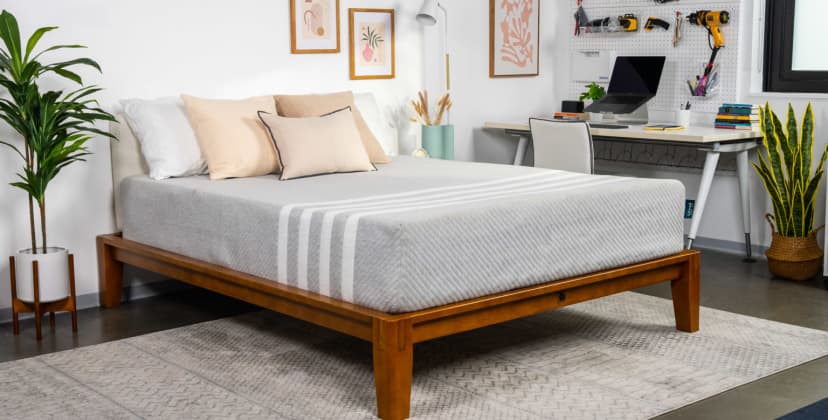
Credit: Sleep Foundation Test Lab
Price
$1,199
Mattress Type
Hybrid
Firmness Options
Medium Firm (6)
Trial Period
120 nights (30-night requirement)
At a Glance
- Who It’s Best for: Side and back sleepers between 130 and 230 pounds.
- Feel: A medium firm (6) design with a comfort system that conforms to the body and a light bounce in response to movement.
- What It’s Made of: A comfort system with memory foam and transitional polyfoam over a pocketed coil support core.
- What We Don’t Like: People over 230 pounds may not receive enough support.
Scoring & Reviews
The following ratings show how suitable this mattress is for different sleeping positions and sleeper weights. These scores are determined by how well the mattress supports and relieves pressure for each sleeper type.
We performed a meta-analysis on 135 validated customer reviews of the Leesa Original Hybrid. This is what people who bought the mattress had to say:- Suitability for Different Sleepers: Several users note the mattress is great for side and back sleepers, as well as people who live with shoulder, lower back, and hip pain.
- Temperature Regulation: Some users claim the mattress is cool and comfortable, but many say the mattress retains heat and sleeps too warm.
- Quality and Durability Concerns: A few users have expressed concerns that the mattress will not hold up well over time, and some say their surface has developed indentations after a few years of use.
- Overall Satisfaction: Most people seem satisfied with the Leesa Original Hybrid. Users call out pressure relief and motion isolation as two of this model’s major strengths.
- Customer Service: Most customers seem satisfied with their experiences with Leesa, and may tout the company for being helpful and responsive when assistance is needed.
Full Details
The Leesa Original Hybrid has a balanced feel and strong cushioning that make it a comfortable mattress for many types of sleepers. The foam layers are especially appealing for people who enjoy light cradling from their mattress during sleep.
How It Performs
The Leesa Original Hybrid has a medium firm (6) feel that appealed to many sleepers on our team, but it earned the highest praise from side sleepers weighing at least 130 pounds and back sleepers up to 230 pounds. Stomach sleepers under 130 pounds also found it comfortable. These groups received the perfect balance of cushioning for areas like the shoulders and hips, while still getting ample support for the lower back.
Sleepers with painful pressure points will appreciate the contouring from the bed’s foam layers. The bed is also a good fit for people who sleep hot. While foam layers do retain some heat, this is offset by the airflow through the coil system.
Construction Breakdown
The mattress begins with a memory foam layer that hugs the body closely, followed by a polyfoam layer with a more responsive feel to prevent uncomfortable sinkage into the mattress. Beneath is a coil system that stabilizes the bed and provides sturdy support. Edges of the mattress are reinforced to help minimize sagging when you sit or sleep near the perimeter. The cover is made of a soft, knit fabric.
Trial, Shipping, and Warranty
Leesa ships the mattress for free to all 50 states. You’ll receive a 120-night sleep trial with your mattress, and a lifetime warranty.
Best Mattress for Back Pain
Silk & Snow Hybrid
7.8 /10
Test Lab Score
$150 off at Silk & Snow
$150 off at Silk & Snow
The Silk & Snow Hybrid boasts multiple features intended to encourage healthy posture while you sleep. Contouring memory foam fills in the natural curve under your lower back to prevent pressure buildup, while a section of firmer coils in the middle third of the bed provides further lumbar support. The company provides a 365-night sleep trial.
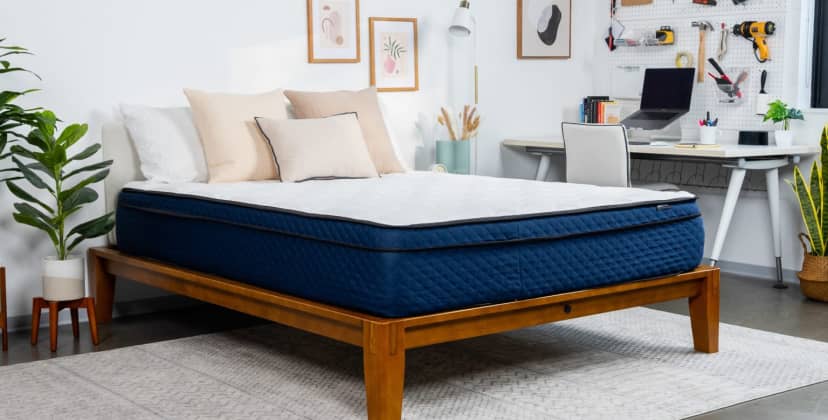
Credit: Sleep Foundation Test Lab
Price
$700
Mattress Type
Hybrid
Firmness Options
Medium Soft (4), Medium Firm (6)
Trial Period
365 nights (30-day requirement)
At a Glance
- Who It’s Best for: Side and back sleepers living with frequent pain in their lumbar region and hips.
- Feel: Available in two designs, plush and adaptive medium soft (4) or a more supportive medium firm (6).
- What It’s Made of: Adaptive polyfoam and memory foam comfort layers, both infused with cooling gel, and a zoned pocketed coil support core with extra perimeter reinforcement.
- What We Don’t Like: Not supportive enough for the average stomach sleeper.
Full Details
Sleepers who feel pressure points in their shoulders, lower back, and hips typically need a mattress that provides a balance of even contouring and sturdy support. The Silk & Snow Hybrid accomplishes this thanks to its balanced medium firm (6) feel, and a foam lumbar pad designed to cushion and reduce pressure in the lower back.
How It Performs
The Silk & Snow Hybrid excelled in a few performance areas. A dense comfort layer combined with a mid-range firmness allows the mattress to contour closely and alleviate pressure along the spine. Steady airflow through the coils also helped the mattress perform well during our temperature control tests. Among our team members, the mattress was most popular with side and back sleepers weighing up to 230 pounds.
Construction Breakdown
The mattress features a Euro-top cushioned with adaptive polyfoam, followed by a memory foam comfort layer. These materials contour evenly to create a cloud-like feel as your body settles into the mattress. A foam lumbar pad cushions the lower back. The pocketed coils are zoned to feel thicker and more supportive beneath the torso and hips. Extra coil reinforcement along the perimeter also reduces sinkage when you get in and out of bed. The entire mattress is encased in a soft and stretchy polyester-spandex cover.
Trial, Shipping, and Warranty
The Silk & Snow Hybrid’s sticker price is below-average compared to other hybrids, and Silk & Snow provides free shipping for customers in the contiguous U.S. and provincial Canada. Each mattress is backed by a 100-night trial period with a 30-night break-in requirement and a 15-year warranty against structural defects.
Best Temperature-Regulating Mattress
Layla Memory Foam Mattress
8.4 /10
Test Lab Score
Get an extra $10 off with exclusive code: sleepy10
Get an extra $10 off with exclusive code: sleepy10
If you like the hug feeling of memory foam, this bed is for you. Thick layers of memory foam and polyfoam wrap around your body to soothe sore spots and prevent pressure buildup. Thanks to its all-foam build, the Layla also ensures that any movements stay where they are instead of traveling across the bed.
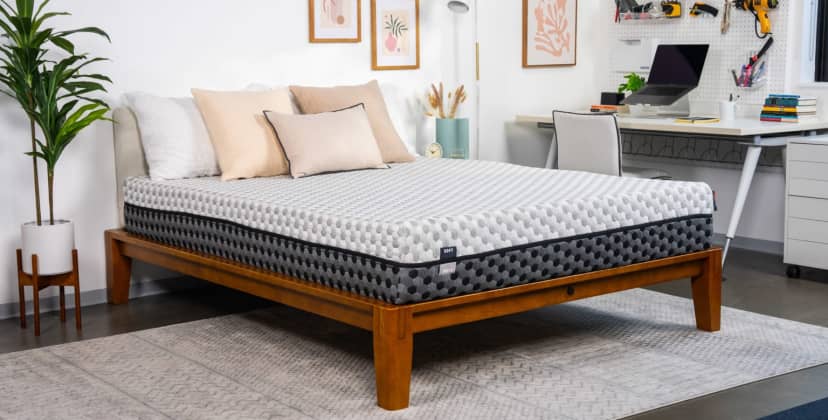
Credit: Sleep Foundation Test Lab
Price
$949
Mattress Type
Foam
Firmness Options
Medium Soft (4), Firm (7)
Trial Period
120 nights (4 week minimum)
At a Glance
- Who It’s Best for: Anyone seeking a mattress that either feels plush and adaptive or firm and supportive.
- Feel: One side is medium soft (4) with a close body contour, while the other is firm (7) and very supportive.
- What It’s Made of: Both surfaces feature memory foam comfort layers, and the softer side also contains zoned transitional polyfoam. A shared support core of high-density foam is sandwiched between the comfort systems.
- What We Don’t Like: People seeking a medium or medium firm mattress may not be satisfied with either side.
Scoring & Reviews
The following ratings show how suitable this mattress is for different sleeping positions and sleeper weights. These scores are determined by how well the mattress supports and relieves pressure for each sleeper type.
We performed a meta-analysis on 7558 validated customer reviews of the Layla Memory Foam Mattress. This is what people who bought the mattress had to say:- Dual Firmness Options: The Layla Memory Foam Mattress offers both soft and firm sides, allowing users to choose according to their comfort preferences, which is highly appreciated for accommodating different sleeping styles.
- Comfort and Support: Many reviewers have noted the mattress provides exceptional comfort, helping alleviate back pain and improving overall sleep quality. The soft side is often described as cloud-like, while the firm side offers adequate support without being too hard.
- Quality and Durability: Users report that the mattress maintains its shape and comfort over time, with no significant sagging or indentations, even after several years of use, indicating good durability.
- Temperature Regulation: The mattress is generally reviewed as doing a good job of regulating temperature, preventing overheating during sleep, which is a common issue with many memory foam mattresses.
- Ease of Setup: Customers appreciate the ease with which the mattress can be set up. It is delivered in a box and expands quickly once unpacked, making it convenient for immediate use.
- Customer Service: Layla’s customer service receives high praise for being responsive and helpful, aiding customers with issues ranging from delivery to product inquiries and returns.
Full Details
The Layla Mattress, a memory foam bed known for its flippable design, features a medium soft (4) feel on one side and a firm (7) feel on the other. This all-foam model is great for those who are unsure what their firmness preference is or want to invest in a bed that provides them with options.
How It Performs
Performance-wise, the Layla stands out in the pressure relief category. The soft side conforms closely to your body to relieve pressure points and performed well for the side sleepers on our test team. The firm side does this less so and proved to be a good option for heavier sleepers on our team — or stomach and back sleepers who needed a more supportive surface. The bed also isolates motion well and produces minimal noise when bearing weight, making it great for couples and light sleepers.
Construction Breakdown
The soft side of the mattress features a thick comfort layer of copper-infused memory foam and a slightly thinner layer of convoluted polyfoam. The firm side features the same copper-infused memory foam but in a much thinner layer. Sandwiched between the two comfort systems is a support core made from high-density foam. A breathable cover made from a blend of polyester, rayon, viscose, and poly-Lycra encases the foam layers.
Trial, Shipping, and Warranty
Layla offers a 120-night sleep trial and a lifetime warranty. Shipping is free to addresses in the contiguous U.S.
Best Mattress for Guest Rooms
Siena Memory Foam Mattress
7.5 /10
Test Lab Score
Up to 50% off mattresses
Up to 50% off mattresses
Guest room mattresses don’t tend to see nightly use, so you shouldn’t feel pressure to fork out the big bucks for a high-end model. The Siena Memory Foam Mattress fits the bill nicely, offering a universally appealing firmness along with decent pressure relief, motion isolation, and edge support.
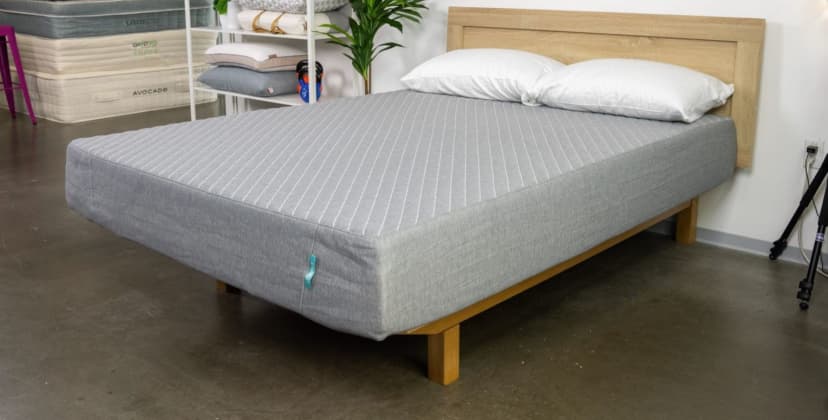
Credit: Sleep Foundation Test Lab
Price
$399
Mattress Type
Foam
Firmness Options
Medium Firm (6)
Trial Period
180 Nights
At a Glance
- Who It’s Best for: Side and back sleepers, especially those between 130 and 230 pounds.
- Feel: A true medium firm (6) feel with gentle cushioning and decent overall support.
- What It’s Made of: Gel-infused memory foam and transitional polyfoam over a high-density foam base.
- What We Don’t Like: Initial off-gassing odor can be strong and linger for several nights after unboxing.
Scoring & Reviews
The following ratings show how suitable this mattress is for different sleeping positions and sleeper weights. These scores are determined by how well the mattress supports and relieves pressure for each sleeper type.
We performed a meta-analysis on 2004 validated customer reviews of the Siena Memory Foam Mattress. This is what people who bought the mattress had to say:- Quality Sleep Improvement: Many users report significant improvements in sleep quality, noting deeper sleep and reduced wakefulness throughout the night.
- Price Value: Many users are impressed with the affordability of the mattress, noting that it offers great value for the price compared to other brands.
- Ease of Setup: Customers appreciate the ease with which the mattress can be set up, highlighting its convenience and user-friendly packaging.
- Temperature Regulation: Several reviews point out that the mattress does a good job of regulating temperature, providing a cool sleeping environment.
- Customer Service: Positive comments about customer service suggest that the company is responsive and helpful in addressing any issues that arise.
- Odor upon Unpacking: A minor drawback mentioned is the initial off-gassing smell common with new memory foam mattresses, but this will dissipate after a couple of days.
Full Details
If you’re furnishing a spare bedroom used on an occasional basis, there’s no need to invest in an expensive mattress, but you should also choose a bed that’s comfortable for your houseguests. The Siena Memory Foam Mattress gives you the best of both worlds. Three foam layers deliver a plush, cradling surface, and couples who stay the night won’t need to worry about bothersome motion transfer or creaky coils when one of them gets up during the night.
How It Performs
During our hands-on tests, the Siena earned its most favorable ratings from our side sleepers weighing up to 230 pounds, and our back and stomach sleepers under 130 pounds. That said, most of us found the mattress comfortable thanks to the balance of surface-level contouring and sturdy overall support.
Construction Breakdown
The Siena’s top layer is composed of memory foam infused with cooling gel, which is intended to dissipate heat and keep the surface relatively cool. Two underlying polyfoam layers add cushioning, but also maintain a stable support system and prevent you from sinking too much. These three layers collectively create a medium firm (6) feel. A breathable knit cover encases the mattress.
Trial, Shipping, and Warranty
Standard ground shipping is free of charge for customers in the contiguous U.S. There’s high potential for off-gassing odor during the first few days after the Siena is unboxed, so we recommend airing it out in a well-ventilated room before sleeping on it. Your order includes a 180-night sleep trial, ensuring ample opportunity to test out the mattress and decide if it’s right for you. The manufacturer’s warranty covers structural and material defects for up to 10 years.
- Quality Construction: High-quality materials often set a good mattress for the money apart from an option that’s merely “cheap.”
- Long Lifespan: A mattress that holds up well and performs over time can be a solid long-term investment.
- Competitive Pricing: Shoppers should seek out a mattress within their budget that offers the same level of quality as its more expensive competitors.
How We Evaluated & Reviewed
Meta Analysis: From the 2,000+ mattresses in our product database, we pulled all models that carry price-points considered “average” or “below-average” for their mattress type, then narrowed down these selections to our 50 top candidates for best mattress for the money.
Hands-On Testing: In our Seattle Test Lab, we thoroughly evaluated the top 50 models using advanced testing tools and technologies. Our team analyzed performance metrics like durability, pressure relief, motion isolation, and temperature regulation.
Field Testing: Next, we sent each the 25 top performers home with a member of our testing team to sleep on for up to two weeks to see how a mattress performs in real-world environment.
User Reviews: We pulled data from roughly 40,000 customer reviews of verified mattress owners to see whether or not our team’s findings match up with customers’ experiences.
The Best Deals of the Week
-
Save $199
—
Brooklyn Bedding CopperFlex Memory Foam
$466 (List Price $665) -
Save $600
—
Helix Midnight Luxe
$1,799 (List Price $2,399) -
Save $2,436
—
Nectar Adjustable Bundle
$1,398 (List Price $3,834) -
Save $771
—
WinkBed
$1,799 (List Price $2,570) -
Save $1,020
—
DreamCloud Classic Hybrid
$699 (List Price $1,719)
Best Mattress Overall
Helix Midnight
9.1 /10
Test Lab Score
25% off sitewide
Shop at HelixA budget-friendly hybrid designed with side sleepers in mind.
See More Details
Best Mattress for Couples
Brooklyn Bedding CopperFlex Memory Foam
8.6 /10
Test Lab Score
30% off sitewide
Shop at Brooklyn BeddingA cushy, wallet-friendly memory foam mattress with zoned support to prevent you from sinking too deeply.
See More Details

Credit: Sleep Foundation Test Lab
Best Value Mattress
Nectar Classic
8.3 /10
Test Lab Score
Save up to 50% on mattresses + 15% off regular prices
Shop at NectarA great all-around foam mattress at an affordable price-point.
See More Details
Best Mattress for Side Sleepers
Bear Original
7.8 /10
Test Lab Score
40% sitewide with code: SF40
Shop at BearAffordability meets comfort in this couple-friendly mattress designed for undisturbed sleep.
See More Details
Best Affordable Luxury Mattress
Leesa Original Hybrid
8.6 /10
Test Lab Score
25% off sitewide
Shop at LeesaA competitively priced hybrid that offers gentle cushioning and support.
See More Details

Credit: Sleep Foundation Test Lab
Best Mattress for Back Pain
Silk & Snow Hybrid
7.8 /10
Test Lab Score
$150 off at Silk & Snow
Shop at Silk & SnowA supportive hybrid with a friendly Canadian price tag.
See More Details
Best Temperature-Regulating Mattress
Layla Memory Foam Mattress
8.4 /10
Test Lab Score
Get an extra $10 off with exclusive code: sleepy10
Shop at LaylaPillow-like pressure relief at an accessible price-point.
See More Details
Best Mattress for Guest Rooms
Siena Memory Foam Mattress
7.5 /10
Test Lab Score
Up to 50% off mattresses
Shop at SienaHave your guests sleep in comfort without spending an arm and a leg.
See More Details
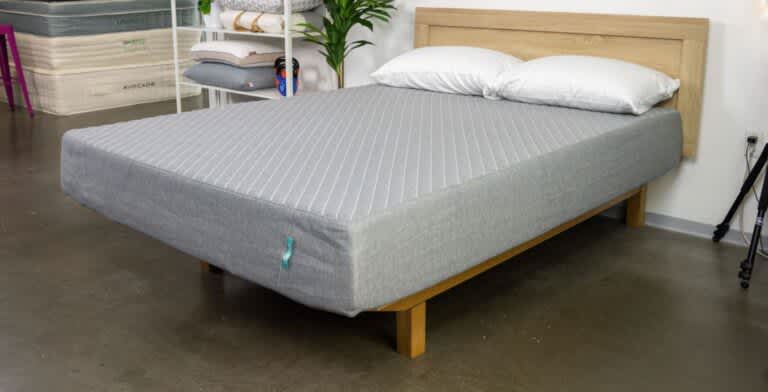
Credit: Sleep Foundation Test Lab
Watch Video: We Tested the Best Mattresses for the Money – Here Are Our Favorites
Watch the video below to learn more about our lab’s best mattress for the money picks.
How to Shop for a High-Value Mattress
Shopping online is one of the best ways to get the most for your mattress dollar. While you can find deals when shopping in a brick-and-mortar store, it’s a trickier task that usually requires good timing and savvy negotiating. Online, though, significant competition makes values far easier to find.
A benefit to shopping online is that it lets you browse at your own pace, researching from the comfort of your home computer. You can learn about the benefits and downsides of different options, read independent reviews, and comparison shop to determine your best options.
Many mattresses sold online are available for the best price when purchased directly from the manufacturer; however, you can find models available from third-party sites like Amazon. Sellers range from smaller, online-only brands to mattress industry powerhouses like Sealy and Tempur-Pedic.
Mattress stores often upsell their products, playing on their customer’s ignorance by selling mattresses above list price. If you do decide to shop in store, make sure you research mattress prices online first.
While there are times of the year that almost always feature sales, including most major holidays (Labor Day, Memorial Day, etc.), promotions are common year-round for mattresses sold online. Discounts are often displayed from the get-go, and if not, you can check third party sites for coupons. These offers can deliver meaningful savings, in many cases cutting the final price by 10% or more.
Standard shipping is almost always included in the price of a mattress sold online. Some sellers offer financing plans, but you’ll generally need to pay upfront (with a credit card, Paypal, or other electronic payment). These mattresses normally have a sleep trial, letting you return the mattress within a set window of time to get a refund.
Important Mattress Value Considerations
Whether you’re looking in the affordable, value, or luxury category, it’s essential that you find a mattress that allows you to get consistent amounts of restorative sleep. That means choosing an option that doesn’t just have a great price but more importantly is the right fit for your needs.
The bevy of brands, products, and marketing lingo can make it tricky to know what to really look for when shopping for a new mattress. Stay on the right track by focusing on these key factors:
- Sleeping Position: Your body needs support in different areas depending on your sleeping position. For example, side sleepers need more cushioning at the shoulders and hips, and back and stomach sleepers need lumbar support. For this reason, it’s vital to consider mattresses that align with your nighttime posture.
- Mattress Type: Five mattress types are readily available: foam, latex, innerspring, hybrid, and airbeds. Each type has pros and cons, and it is helpful to think about which most appeals to you. There are values to be had in every category, but we often find the best values are foam and hybrid mattresses.
- Durability: Once it starts to wear out, a mattress won’t offer sufficient comfort or spinal support. As a result, to be a great value, a mattress has to be durable. To find a mattress that’s more likely to last, look for high-end materials, thoughtful design, and no “weak links” in the layering.
- Quality Materials: As with so many consumer products, you can tell the difference when something is made with high-quality materials. Sturdy components should be used in all levels of the mattress, and in general, customers should be wary of extremely thin or seemingly flimsy layers.
- Firmness Level: Even if the price looks like a screaming deal, a mattress isn’t a value if it’s not comfortable. The central factor that affects comfort is firmness, so look for a mattress that matches what feels right to you.
- Motion Isolation: On some mattresses, especially old-school innersprings, you notice anytime someone moves on the other side of the bed. Many newer mattresses, especially memory foam options, dramatically reduce this motion transfer, making it easier for people who share a bed to sleep through the night.
- Pressure Relief: Certain areas of the body receive greater amounts of pressure than others, and thin cushioning can result in painful pressure buildup. Insufficient pressure relief can also cause the spine’s alignment to be thrown off, leading to back aches. As a result, contouring and pressure relief are important features, especially if you have sharp impact points.
- Ease of Movement/Sex: For many sleepers, it’s important to be able to move with ease across the surface of the mattress. This could be during sex or when changing sleeping positions at night. It’s easier to move on a mattress with bounce, and some beds with deep contouring (like memory foam) can inhibit movement more than hybrid and latex options.
- Edge Support: To get the most of your mattress, you want to be able to use its entire surface, but some beds give out around the edges. Soft mattresses, as well as all-foam beds, tend to have the least edge support. Latex and hybrid mattresses usually offer more integrity around the perimeter.
- Temperature Neutrality: Heat can build up around your body at night, making it hard to stay asleep. Heat problems come from a lack of airflow around the body (often associated with deep hug) and heat retention by some materials (especially memory foam).
Why Buy a New Mattress?
Whether your budget is big or small, mattresses can be a sizable investment. For this reason, sleepers usually buy new mattresses out of necessity — usually to replace a mattress that no longer suits their needs. We polled thousands of Sleep Foundation subscribers to find out the top reasons people buy new beds. Below are our results.
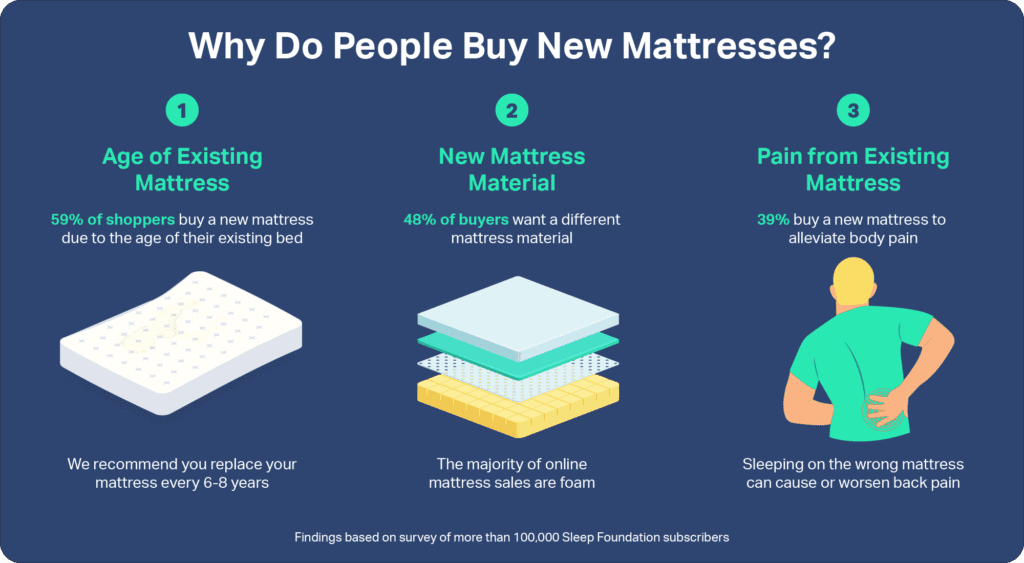
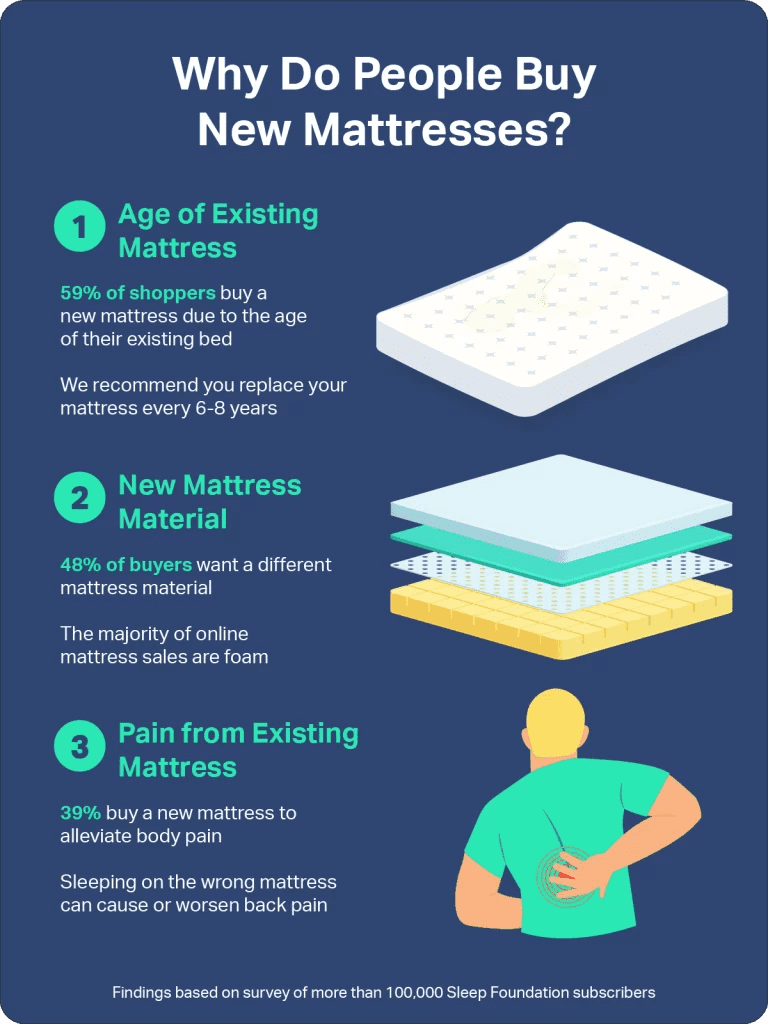
What Can Affect the Price of a Mattress?
As you start shopping for a new mattress, you’ll find that prices can be all over the map. Understanding what affects the price of a mattress can help you detect a good value. Some of the most important factors to know include:
- Type of mattress: On a broad level, certain types of mattresses, like airbeds, tend to be more expensive, and others, like innersprings, are usually more economical.
- Size of mattress: Size plays a major role in the cost of your mattress. The smaller the mattress, the lower the price. This means twin, twin XL, and full beds will cost less than queen, king, and California king beds.
- Thickness of layers: Some materials have a higher cost, and when they are included in thick layers, it can push up the price of a mattress. For example, a mattress with 1 inch of memory foam in its comfort system will usually cost less than a mattress that is otherwise comparable but has a 3-inch memory foam layer.
- Quality of materials: This is one of the key determining factors because higher-end materials cost more to produce and make a mattress more expensive. Elements of materials quality that can affect the price include its sourcing, its density (in the case of foam and latex), whether or not it’s made by hand, and the complexity of its construction (as with innerspring coils).
- Eco-friendly production: It typically costs more to make organic or environmentally friendly materials, and getting a product certified can bring on additional costs.
- Cooling features: Many mattresses have extra features to try to maintain a stable temperature. These can include foams infused with gel or copper, open-cell or aerated foams, phase change material (PCM), and infrared-producing textiles, all of which contribute to a higher price tag.
- Design elements: Adding extra design features, such as zoned coils and foams, reinforced edges, sewn-on handles, or pillow-tops may affect the total price.
- Where it’s manufactured: If a mattress is made in the U.S., it will likely cost more, especially if most or all of the component parts are made in the U.S. as well.
Shipping, Returns, and Warranties
If you’re in the market for a new mattress and shopping online, you might be wondering about how shipping, returns, and warranties are handled and if they end up affecting the cost of your new bed.
Shipping
Basic ground shipping to your home is almost always free for a mattress bought online. With standard shipping, the mattress is compressed, shrink-wrapped, and mailed as a mattress in a box to your door. When it arrives, you take the box to your bedroom, and when you remove the packaging, the mattress will retake its complete size.
Standard shipping normally takes a few business days depending on where you are located and where the mattress ships from, which is usually a production facility or warehouse. Before shipping, some companies require a few extra days to process your order and/or build the mattress.
This delivery method is usually free for customers who live in the contiguous United States. Standard shipping to Alaska, Hawaii, or international locations is offered by some companies but generally with an extra cost.
White Glove Delivery
Another option for delivery includes actually setting up the mattress in your bedroom. This service often includes removal of an old mattress at the same time.
A few companies provide White Glove delivery for free with the purchase of a mattress. Others offer it for an extra charge, and in some cases, there may be different prices for installation alone as opposed to installation and removal of an existing mattress.
White Glove delivery may not be available in all areas, including in places outside the contiguous 48 U.S. states. In those places, customers in need of these services can look for third-party companies that help with these types of projects.
Returns
Generous return policies are commonplace in the online mattress industry. With most brands, you can expect to have a sleep trial that lets you try out the bed at home with the option to return it if it doesn’t work for you.
Most sleep trials are around 100 nights, but some last for even a full year. In many cases, you’ll be required to keep the mattress for a period of time — usually up to a month — before starting a return so that your body can adjust to a new sleeping surface.
If you want to return the mattress, you won’t need to try to get it back in the box. Many companies will send someone to pick it up from your home, and then the company will donate the bed. This is a simpler method, although you may need to move the mattress to your front door or curb.
Other companies don’t pick the mattress up but instead require that you donate the mattress and provide a copy of the donation receipt. If you are unable to personally coordinate donation, you can speak directly with the manufacturer for assistance.
The majority of companies offer a sleep trial that has no restocking or return shipping fees; however, you should always check because in some cases there are costs deducted from your refund. Costs above-and-beyond the mattress itself, such as for expedited shipping or White Glove delivery, are almost never refunded if you opt for a return.
These typical return policies apply to mattresses purchased directly from the manufacturer. If you purchase from a third-party retailer (like Amazon), the length and terms of the return policy may be different.
Warranties
A warranty is a guarantee against defects in a mattress. These warranties cover abnormal or premature deterioration but not typical wear-and-tear. A minor amount of sagging that occurs gradually over time is expected from most mattresses and won’t usually be covered by a warranty.
Mattress warranties can have complicated terms. One component is the length, which often runs from 10 to 25 years. Another component is the remedy, which is what the company will do if a defect arises. Most often, the company will have the choice of either repairing or replacing a defective bed.
Whether you have to pay anything, including shipping costs, as part of this remedy also depends on the terms. A prorated warranty provides less coverage over time, requiring you to pay an increasing portion of the repair or replacement costs based on how long you’ve had the mattress. A non-prorated warranty offers the same coverage no matter how long you’ve had it.
The most valuable warranties are long, cover a broad range of defects, are non-prorated, and do not require the customer to pay any shipping costs.
Additional Mattress Costs
The cost of the mattress itself is not the only item to account for as outfit your bedroom. While these won’t apply for every shopper, they are important to think through as you plan to make your mattress purchase.
- Foundations and Bed Frames: If you either need or want a new base for your bed, you’ll need to factor that into your budget. Make sure that any bed base properly supports the mattress so that you don’t inadvertently void the warranty. If you want to use an adjustable frame, confirm that the mattress you want is compatible.
- Bedding: Most mattresses are clothed with a sheet set, pillows, and a comforter or duvet. If you get a new mattress that’s a different size than your old one, you may have to replace your some of these to accommodate the new size. We also recommend purchasing a mattress protector to protect your bed from things like spills and skin cell buildup.
- Old Mattress Removal: To make room for a new mattress, you’ll need to clear out the old one. Haul-away may be included with White Glove delivery or may be provided by local organizations. Charges for haul-away vary by location.
- In-Home Assembly: White Glove delivery from the mattress maker can come at a cost, but if it’s not offered, you can likely find a local service provider to get your bed set up. This can be especially useful if you are also purchasing a new bed base. Prices will vary based on location and how many pieces you need assembled.
Types of Mattresses
The following sections give an introduction to the five key types of mattresses. Within each mattress type, you can expect commonalities, but it’s important not to assume that all mattresses within a category will have the same performance. There can be variation depending on the specifics of how the mattress is built, the quality of its materials, and other factors.
Hybrid
Definition: As the name indicates, a hybrid makes use of multiple different materials. A hybrid always has a support core made with innerspring coils. The comfort system, though, can utilize memory foam, polyfoam, latex, microcoils, and other textiles. The comfort system is thick and noticeably affects the overall feel of the bed.
Balanced Performance: The goal of a hybrid is to provide the benefits of various materials without triggering their drawbacks. A hybrid can provide the responsiveness and edge support of an innerspring but with the pressure relief and comfort of a foam mattress.
Innerspring
Definition: Innersprings have one central component, which is a coil system. The coils, or springs, compress and bounce back as you move on top of the mattress. The comfort system is sparse or non-existent, featuring at most thin layers that are usually made with cotton or polyester.
A Low-Cost Building Block: Some customers choose to “DIY” their own hybrid by first purchasing an innerspring mattress and then placing their preferred mattress topper above it to serve as a comfort system. This requires separate purchases but offers flexibility and can bring cost savings.
Latex
Definition: The performance of a latex mattress is driven by latex rubber. The latex used in mattresses is usually natural, meaning that it is derived from trees; however, latex can also be produced synthetically. Natural latex can be made using the Dunlop or Talalay process, which will affect its overall feel.
Responsive With Contouring: Latex has an appealing mixture of cushioning and bounce. It can lightly cradle the body, but it’s also easy to move on top of, which keeps you from feeling stuck in the bed.
Airbed
Definition: The defining feature of an airbed is its support core that is made with an air chamber. That chamber can inflate or deflate, changing the firmness with the touch of a button on a remote or smartphone. Comfort systems above the air chambers vary widely and can include foam, latex, wool, cotton, and/or fiber fill.
Choose Your Own Firmness: Customers who want the ability to adjust their mattress firmness are big fans of airbeds. In addition, each side has a separate chamber, which works great for people who share a bed but have different firmness needs.
Foam
Definition: Foam mattresses are built with an array of layers that can include polyfoam, memory foam, and latex. No coils or spring are used in foam beds. The feel of a foam mattress depends in large part on the type of foams used and the thickness of the layers.
Standout Contouring: Foam mattresses, especially memory foam options, lead the pack when it comes to contouring and pressure relief. This can promote healthy spinal alignment and make the bed more comfortable for people with pronounced pressure points.
| Mattress Type | Average Lifespan | Average Price |
|---|---|---|
| Innerspring | 5 to 7 years | $900-$1,100 |
| Foam | 6 to 7 years | $900-$1,200 |
| Hybrid | 6 to 7 years | $1,600-$2,000 |
| Latex | 8 years or longer | $1,600-$2,000 |
| Airbed | 8 years or longer | $2,000-$2,400 |
How to Get The Best Deal on a Mattress
One of the best ways to get the best mattress for your money is to score the best deal possible. The next sections explain some helpful steps to be a savvy mattress shopper.
Do Your Homework
A little bit of research can go a long way in helping you save money on a mattress. Understanding the normal price ranges and what influences price can fine-tune your ability to spot a good deal.
Comparison shopping is another useful money-saving strategy. Without the pressure of a salesperson, you can collect information at your own pace and see how similar models are priced. Knowing about competitors’ pricing enables you to more effectively negotiate and ask for price matching or other deals.
When doing your research, make sure to be on the lookout for bundles, especially if you also need a new bed frame, pillows, or bedding. Many companies offer free extras, or you can negotiate for them to be included with your purchase.
Holiday Deals and Sales
Holiday sales are a big deal in the mattress industry. Historically, brick-and-mortar stores offered the best values on a handful of holidays because of the nature of the mattress sales cycle. New models were regularly launched in the early summer, creating a motivation to clear out inventory with big sales around Memorial Day. The Fourth of July and Labor Day anchored sale events to promote the new mattress lines. In addition, other major shopping days, like Black Friday, have been a staple for retail mattress stores.
Fortunately for shoppers, the online mattress industry has followed suit, offering great values on holidays to compete with brick-and-mortar stores. They’ve even added new holidays – Prime Day and Cyber Monday – to the list.
| Holiday | When it Happens |
|---|---|
| President’s Day | 3rd Monday in February |
| Memorial Day | Last Monday in May |
| Independence Day | July 4th |
| Amazon Prime Day | July 15th |
| Labor Day | First Monday in September |
| Veterans Day | November 11th |
| Black Friday | The day after Thanksgiving |
| Cyber Monday | Monday after Thanksgiving |
If you can shop on these holidays, you likely won’t have to look hard to find promotions. Retail stores publish ads and flyers, and online companies have banners and pop-up ads that show major savings. You can usually find reduced prices, free accessories, or both.
If you aren’t able to make a purchase around these dates, it can still be useful to make note of holiday deals. Keep a record of the details, and then later, you can ask for the same pricing. While this negotiating tactic won’t always work, some sellers will end up giving you the price offered during a prior sale.
How We Test: Your Comfort Is Our Science
Our industry-leading product testing team cares deeply about improving your sleep. Having a holistic understanding of a mattress’s role as part of a sleep system is paramount to our testing process. Since a bed’s comfort and feel depend largely on body weight and sleeping position, our testing team represents a wide range of body types, sleep positions, and comfort preferences.
In our Seattle-based Test Lab, we use an objective, hands-on process to evaluate mattresses across performance categories. The following are the key guidelines that inform our performance ratings. Our ultimate goal is to ensure you have all the information you need to make the best purchase decision for you.
Construction analysis: We begin testing each mattress by analyzing its design and making note firmness, height, individual layer composition, and sticker price. This allows us to evaluate qualities like support, durability, and value.
Product testing: Firsthand testing is crucial to our evaluation and ratings system. We use a wide range of tools and technology to test mattresses in six performance categories: motion isolation, pressure relief, temperature control, ease of movement, edge support, and odor potential.
Field testing: In addition to lab-based tests, we base our ratings on feedback from field testers who use the mattresses in their own homes. They spend several weeks collecting data — this gives us insights into how the mattress performs night after night for an extended period.
User testing: We curate feedback verified owners have provided in surveys, sleep stories, and product reviews. This helps us evaluate our initial findings and, if needed, tweak our ratings to reflect real-world experiences.
How We Determine Our Overall Scores

To determine a mattress’s overall score, we assign weighted percentages to performance categories based on how important they are to the individual sleep experience. For instance, areas like pressure relief and temperature control tend to matter more to people than something like off-gassing, and because more people sleep on their side and back than on their stomach, we weigh those positions more heavily.
Performance Categories
Motion Isolation
This criteria alludes to the amount of motion a mattress absorbs when a sleeper moves on the surface. We use two testers lying side by side to evaluate motion isolation, who each feel for transfer while the other person moves on the mattress.
Temperature Control
To determine how well a mattress regulates temperature, we perform temperature tests and look closely at its materials and construction. Many mattresses are designed with cooling components meant to reduce heat retention.
Pressure Relief
A bed with strong pressure relief excels at preventing pressure from building up in areas like the shoulders and hips. Beds with even contouring and weight distribution are top performers when it comes to pressure relief.
Off-Gassing
A mattress in a box may release unpleasant chemical odors for a short period after you’ve unboxed it. The initial smell may be strong but typically fades within 2 or 3 days.
Ease of Movement
This criteria reflects how easily a sleeper can move across a bed’s surface. Responsive surfaces made of latex typically perform better than foam surfaces, which can inhibit movement.
Edge Support
We perform sit tests along a bed’s perimeter to measure how well the edges push back against weight. Mattresses with strong edge support have minimal sagging when sleepers sit on or lie close to the perimeter.
Dive Deeper – Mattress Guides by Price
For more help in finding the best value bed that meets all of your needs, take a look at our recommendations sorted by price points.

Still have questions?
Our product experts have extensive experience testing just about every sleep product on the market.
Send an email to AskAnExpert@sleepfoundation.org with your questions and we’ll help you find exactly what you’re looking for.
